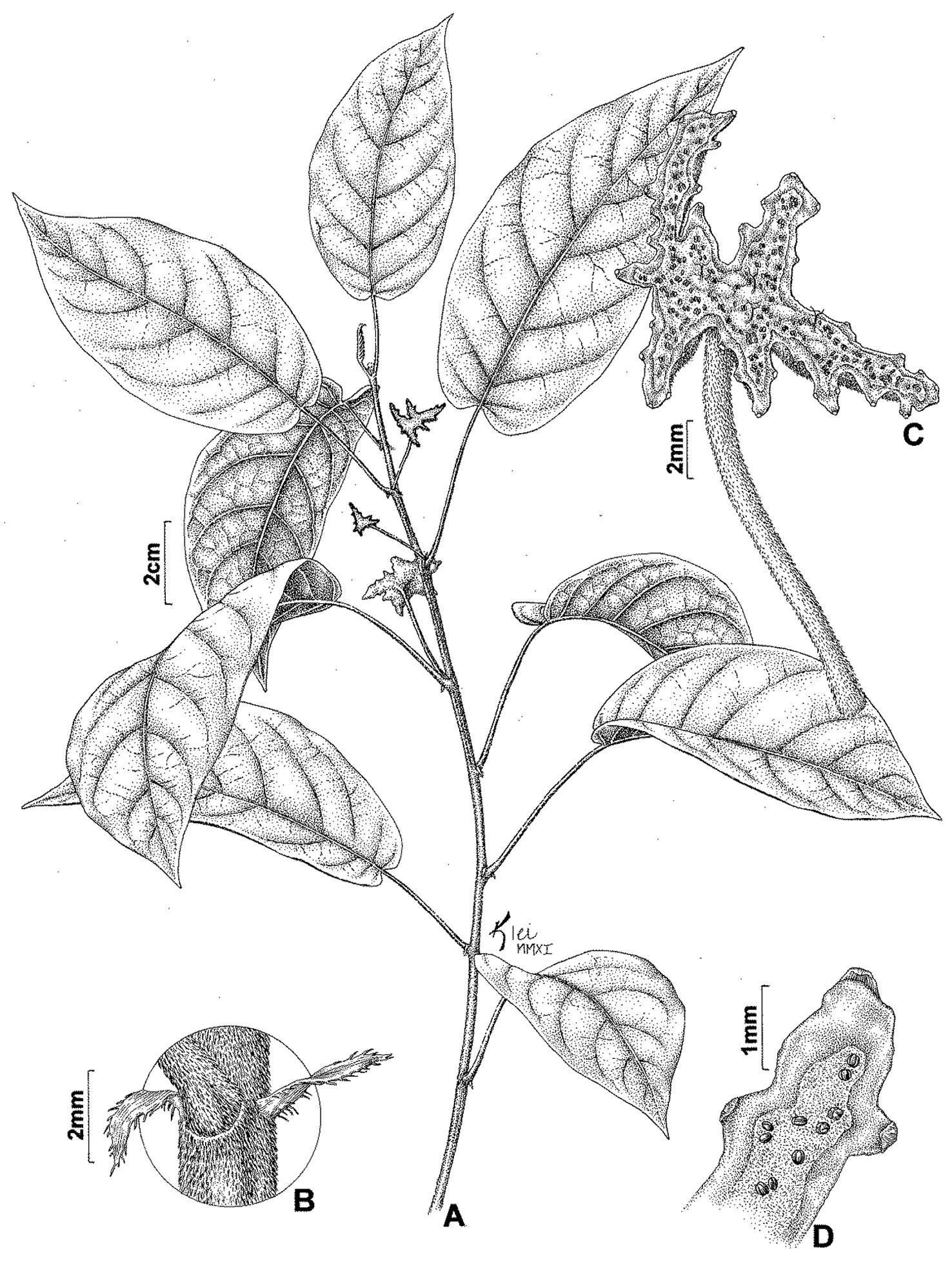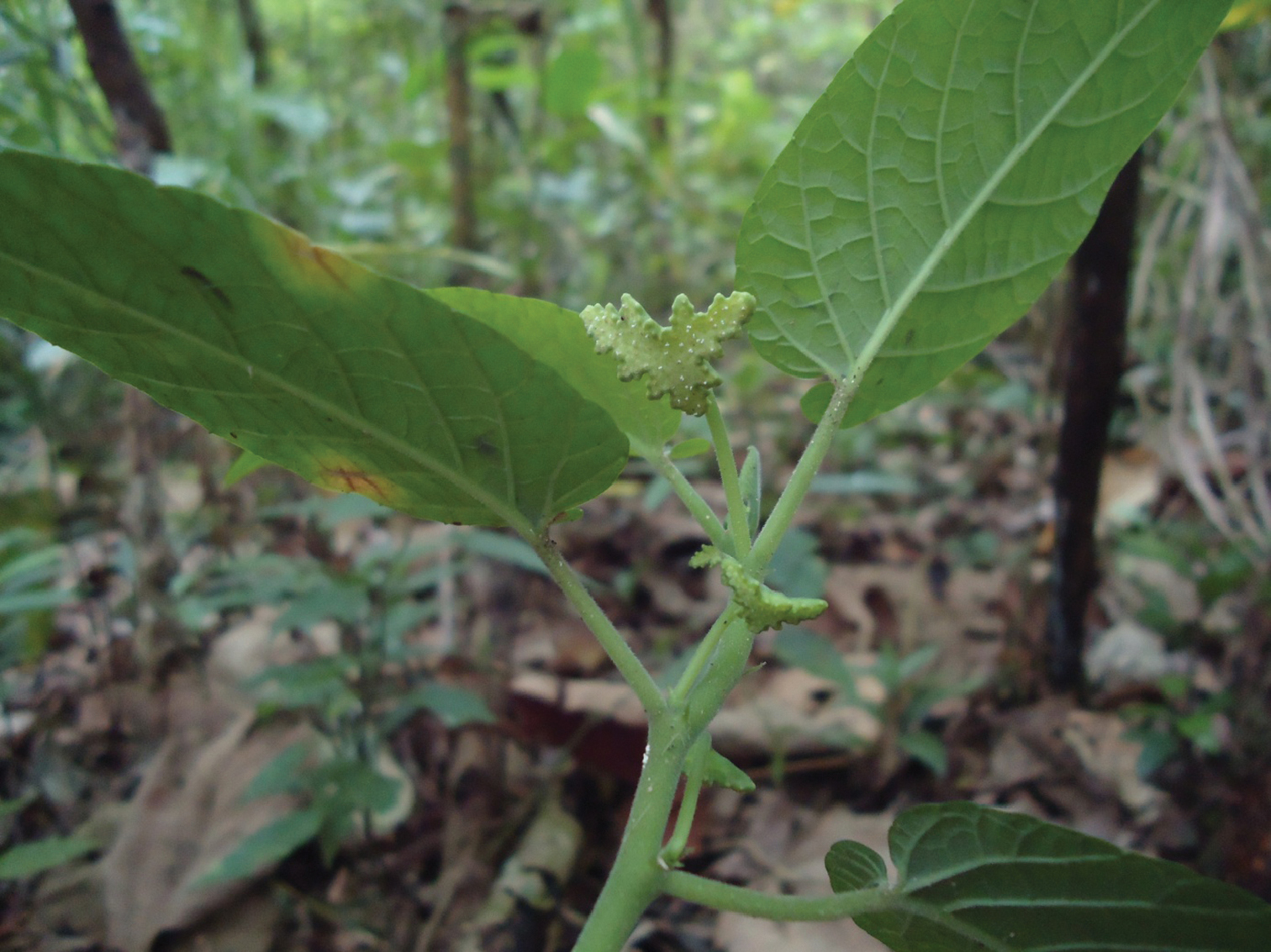






(C) 2012 Alessandra dos Santos. This is an open access article distributed under the terms of the Creative Commons Attribution License 3.0 (CC-BY), which permits unrestricted use, distribution, and reproduction in any medium, provided the original author and source are credited.
For reference, use of the paginated PDF or printed version of this article is recommended.
Dorstenia stellaris is a new species from southeastern Brazil. This species is endemic to the region and differs from the others by its star shaped coenanthium and cordiform leaves. A description and illustration of this species is presented here. Dorstenia stellaris is found in moist and shady places, in small populations within the type locality, thus we recommend its inclusion in the endangered (EN) status of conservation.
ResumoDorstenia stellaris é uma espécie nova do sudeste do Brasil. A espécie é endêmica da região e difere-se das demais, pelo cenanto estrelado e folha com base cordada. Neste trabalho foi apresentada descrição e ilustração da espécie. Dorstenia stellaris é encontrada em locais úmidos e sombreados, em pequenas populações, somente na localidade típica, desta forma, recomendamos sua categorização como em perigo.
Atlantic forest, Mantiqueira, Pindamonhangaba
Dorstenia was described by Carl
The great number of species and morphological variation in this genus is reflected by numerous infrageneric groups established by
Dorstenia is the only genus in the family that shows an herbaceous habit and its populations often tend to occupy restricted areas with favorable ecological niches. Dorstenia stellaris is endemic to Mantiqueira Ridge area and has a restricted distribution, being found only on its type locality, in the municipality of Pindamonhangaba. This species occurs in small populations along moist and shady areas.
Taxonomic treatmenturn:lsid:ipni.org:names:77119223-1
http://species-id.net/wiki/Dorstenia_stellaris
Fig. 1 A–D; Fig. 2Coenanthium ellipticum, irregulariter stellatum et lamina basis cordiformis differt.
BRASIL. São Paulo, Pindamonhangaba, distrito de Ribeirão Grande, near Fazenda São Sebastião do Ribeirão Grande, 26 Nov. 2011, A. Santos et al. 142 (Holotype: SP!); Brasil. São Paulo, Pindamonhangaba, distrito de Ribeirão Grande, Fazenda São Sebastião do Ribeirão Grande, 30 Mar. 1994, I. Cordeiro et al. 1323 (Paratype: SP!); São Paulo, Pindamonhangaba, distrito de Ribeirão Grande, near Fazenda São Sebastião do Ribeirão Grande, 26 Nov. 2011, A. Santos et al. 143, 144, 145, 146 (Paratype: SP!).
Camephytes 30–70 cm tall; stems aerial, erect, hirsute to tomentose; internodes 1–2.5 cm long.; latex white and abundant. Stipules 1–2 mm long., subulate, narrowly triangular, ciliate, persistent to deciduous, hairs white. Leaves distichous to whorled; blade 8–12 × 3.5–5 cm, membranaceous, apex long acuminate, base cordate, adaxial side scabrous, hairs sparse, white, abaxial side puberulous to hirsute, hairs gathered on the veins; margins entire to denticulate; petiole 2.5–5 cm long., hirsute; brochidodromous venation; 5–6 pairs of secondary veins; tertiary veins scalariform. Coenanthium elliptic, 1–2 cm diam., pateliform, stellate, 3–5 angulate, puberulous; margin with sessile bracts, 0.5–1 mm long., mostly on the angle apex, puberulous, fringes 0.5–0.7 mm alt., greenish to vinaceous; peduncle 1.5–2.5 cm long., puberulous. Staminate flowers distributed through the whole coenanthium; stamens 2; perianth 2 lobed. Pistilate flowers distributed through the whole coenanthium: perianth short lobed, whit apex minutely 2–3 lobed, puberulous; stigma 0.5–1 mm long., slender, white. Drupes elliptical, endocarp smooth to verrucosus; stigmas persistent. Seeds with a flat testa.
Dorstenia stellaris A.Sant. & Romaniuc A habit B ciliate stipule C stellate coenanthium D inflorescence, detail of coenanthium fringes and bracts on the angles of the coenanthium margin. (A. Santos et al. 142).
Dorstenia stellaris inflorescence, detail of coenanthium (photo: A. Santos 2011).
Morphological comparison between Dorstenia species related to Dorstenia stellaris.
| Taxa | stellate coenanthium | angulate coenanthium | rounded coenanthium | subulate stipule | base cordate leaves | base<br/> acute leaves |
|---|---|---|---|---|---|---|
| Dorstenia stellaris | x | x | x | |||
| Dorstenia bowmaniana | x | x | x | |||
| Dorstenia carautae | x | x | x | |||
| Dorstenia milaneziana | x | x | x | |||
| Dorstenia setosa | x | x | x |
Collected with flowers in march and november, and fruits in march.
Dorstenia stellaris is a camephyte from shady and moist areas within the Atlantic forest, which occur in litter soils, near waterfalls inside forests of the type locality.
The angulate shape of Dorstenia bowmaniana, and Dorstenia carautae coenanthium is similar to that Dorstenia stellaris, however, the differs on the strongly irregularly-stellate coenanthium and on the cordate leaves. Dorstenia milaneziana and Dorstenia setosa are also similar to Dorstenia stellaris by the cordate leaves, however, they differ from Dorstenia stellaris by the rounded coenanthium. The other species of the Lecanium section are mostly orbicular to elliptic coenanthium.
As Dorstenia stellaris is a newly described and very restricted taxon occurring in a non-conserved area, it warrants special attention with regard to its conservation status. This species has only been found within its type locality in small populations. We believe, indeed, that this species is endangered and following IUCN (2011) criteria we recommend its classification within the endangered status of conservation (EN).
stellaris epithet refers to the irregularly-stellate shape of the coenanthium.
This study was financially supported by Conselho Nacional de Desenvolvimento Científico e Tecnológico (CNPq). We are grateful to Rafael Felipe de Almeida for translating the paper and Dr. Jorge Pedro Pereira Carauta for all suggestions. The authors are also grateful to the graduation program on Plant Biodiversity and Environment from Instituto de Botânica of São Paulo.

